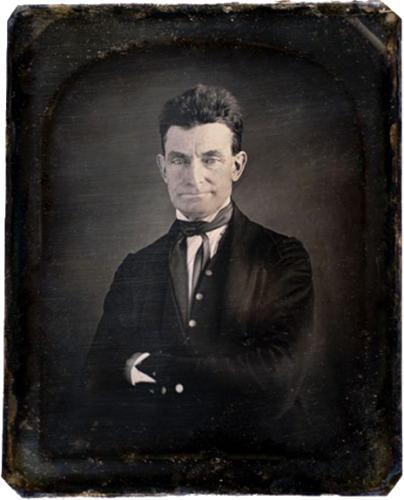One Midnight Rising is about men who make secret plans and train for battle, intent upon killing as many men as they can in pursuit of their goals. They hide in attics and cellars during the day and venture out only at night; they dream of blood. The other Midnight Rising is about vampires.
They share a title. But that is not all they share. Which is interesting considering Tony Horwitz’s book is a meticulously researched historical narrative while Lara Adrian’s is an erotic thriller depicting “a world of dark desire and endless night.”
First, the protagonists in both books mourn for lost parents. John Brown, a failed businessman turned abolitionist crusader, was eight years old when his mother died in childbirth. Rio (one of a “hybrid race of humans bearing vampiric, alien genes”) never knew his father, and his mother tried several times to kill him. Rio’s human lady friend, Dylan, grew up without a father after he abandoned the family; her mother is dying of cancer. Brown’s status as a motherless child was not unusual, given the high mortality rates (especially for women in childbirth) in nineteenth-century America. But orphaned children are also compelling protagonists in both historical and fictional narratives. As the literary critic Eva König has recently argued, orphans have been “indispensible for the literary imagination of successive generations.” Lacking one or both parents, these figures are often rootless, a state of being that prompts either the pursuit of new experiences or the search for a different kind of family. Their plight creates sympathy, and admiration for their aspirations.

Second, both Midnight Risings employ secrets—and consequent revelations—as plot devices. Rio and Dylan meet in a crypt hidden in a cave in the mountains of the Czech Republic. The reader knows he is a vampire; much of the book is rooted in this dramatic irony, and builds to the moment in which Dylan discovers that vampires, in fact, exist. She handles this news quite well, by the way. It is vital that no one else knows; exposure promises “persecution, subjugation, and ultimately, wholesale annihilation” for vampires like Rio. The clandestine nature of John Brown’s plan to instigate a slave insurrection across the South in the late 1850s creates similar kinds of dramatic tension in the first two parts of the Horwitz’s book: will one of the raiders’ letters home be intercepted? Will the schemers be discovered, hunkered down in their farmhouse outside Harper’s Ferry? When will the residents of the town finally realize what is happening? Secrets and the possibility of exposure create narrative momentum; this is particularly useful in historical narratives. Usually, we know what happens in the end and so the trick is to convey that people living in the past had no idea how everything would turn out. Incidentally, all of these clandestine activities—both vampiric and abolitionist—are funded by secret organizations based in Boston. Make of that what you will.
Third, both books have a magnetic, virile male protagonist. Rio’s body is damaged—he suffered serious burns and wounds over half of his body during an explosion in a previous book in the series—but it is a magnificent body nonetheless.

Dylan takes one look at “his scarred, yet ruggedly attractive face, the powerful body contained within his expensive new clothes, and she wanted to know more.” And, of course, she does know more (as does the reader)–this is an erotic thriller, after all. Now, John Brown may not have been all that physically attractive, but Horwitz notes that he was compelling to men and women alike. Supporters described his “pent-up fire,” his “countenance and frame charged with power.” One said, “’I think him about the manliest man I have ever seen.’” John Brown, in many ways, was an unlikely leader of men; he was a failure at many professions he attempted and he was not a great strategist. But he drew followers to him and gained the support of many of the Northeast’s elite despite these weaknesses. Manly magnetism can set all manner of plans in motion, it seems.
Now, you might be saying to yourself, “This is ridiculous.” I certainly thought so when I opened the Amazon box and figured out that I had ordered the wrong book for my class (I’ll let you imagine which one that was). But reading both Midnight Risings together shows us how closely aligned historical and fictional narratives can be.
And in honor of these overlaps and curious connections, read the quotes below and choose: A). Erotic vampire thriller? Or B). History book about radical abolitionism? Answers in the next Historista post.
- “There wasn’t much of anything he cared about—save his oath of honor pledged to his brethren of the order.”
- “They came in the night and dragged them from their beds, breaking open heads and lopping off limbs. The killers wore no masks, plainly stated their allegiance, and left maimed victims lying in the road or creek.”
- “The men traveled only at night; by day, they hid in laurel thickets as mounted patrols galloped past in the valley below.”
- “It had taken him many years to rise above the dark origins of his birth and do something meaningful, to make something good of his life. He thought he had.”
- “This life is intended as a season of training, chastisement, temptation, affliction, and trial.”
- “She searched his face for some hint of emotion beyond the stony resolve he projected. All she saw was a man fully prepared for the task he’d been given, a warrior committed to his mission.”
Congratulations on a great new blog.
Huzzah! The Historista has arrived in all her glory! Brava! And I agree with the other comments: the less glitter with vampires, the better. Now back to plotting how I can fund my own secret society here in the South.
Are 1, 4 and 6 by Lara? If not, we have some idea why Tony’s “history” sells so well.
You are correct, LeeAnn! #winnah
You left out whether the vampires are sparkly. Maybe that happens after the Civil War. What’s next? Werewolves?
I’m going on the record with “B” for each.
Megan — Well done. If future posts will have this kind of whimsical connections, then we’ll all be very happy (except maybe for Kevin who is apparently eschewing vampires). I will share this post with my wife since in addition to admiring your comfortable fashion sense has probably read the version of this title NOT about John Brown.
Love it!
Here are my guesses :)
Loving the blog and looking forward to reading more posts.
And, oh do I love quizzes that link history with pop culture! Here’s my attempt:
1. A
2. B
3. B (but it could go A)
4. A
5. B
6. A (but it could go B)
You are a genius, Kristen! #winnah
LOVE the post! LOVE the commentary from your witty fellow historians! Can’t wait to read the next one.
It’s up! Congratulations! It looks fabulous. I love that the first post is a vampire related one. I look forward to others given our discussions.
Only your brilliant imagination would be able to put these books in dialogue! #interdisciplinarity
Great post, Megan. I’m so happy to see your blog up and running! When I have discussed the film _Abraham Lincoln, Vampire Hunter_ with students, I have them read the following quotation, which I think shows that at least Garrison linked a few of these “plot devices” in the antebellum period. Has anyone read other historical references to slavery and slaveholders as vampires?
“People of New-England, and of the free States! is it true that slavery is no concern of yours? Have you no right even to protest against it, or to seek its removal? Are you not the main pillars of its support? How long do you mean to be answerable to God and the world, for spilling the blood of the poor innocents? Be not afraid to look the monster Slavery boldly in the face. He is your implacable foe—the vampyre who is sucking your life-blood—the ravager of a large portion of your country, and the enemy of God and man. Never hope to be a united, or happy, or prosperous people while he exists. He has an appetite like the grave—a spirit as malignant as that of the bottomless pit—and an influence as dreadful a the corruption of death. Awake to your danger!”—William Lloyd Garrison, _The Liberator_, December 29, 1832
Brian, this quote is GENIUS. I’m going to use it in a future post (with a H/T to you, of course). And yes, there will be a few more posts about vampires. #BecauseVampires
I hope your vampires don’t have glitter! A historian friend of mine, who passed away way too early, biggest hatred was this new glitter, adored vampires. Why cannot we return to the Ann Rice vampires? Could Lestat de Lioncourt have been George Pickett?
Ray
Looks fabulous!
I was going to echo Kevin’s guess, but I really don’t think Horowitz is capable of that first sentence. You, on the other hand, are clearly capable of anything! Mazel tov, and curse you for giving me one more reason not to abandon FB content aggregration.
Oddly, you seem to have ignored the vast trove of abolitionist porn at the John Carter Brown library. Just what kind of historian are you anyway?
And because I know that you wanted to be the first comment on Historista, I have approved this one. ; )
Cool site! I like the premise!
And I’m going to guess “B” for each quote. :-)
Because I know you are sitting by your computer waiting for the first comment. Congratulations, Megan! The site looks great. :-)